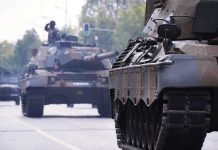
What if the next revolution in ground warfare doesn’t rumble in on tank treads but rolls in quietly on truck tires, unmanned, unflinching, and firing a .50 caliber machine gun from miles away?
Story Snapshot
- Ukrainian engineers are live-testing a remote-controlled truck, the Protector, mounting a .50 caliber gun turret
- This platform can deliver heavy firepower while operators remain hundreds of miles away from danger
- The vehicle’s design shifts the paradigm from stealthy robots to high-capacity, fast-moving gun trucks
- Ukraine’s military codified both the drone truck and turret for official battlefield use, signaling a leap in uncrewed warfare
Ukrainian Drone Trucks: A New Breed of Battlefield Power
Ukrainian Armored Vehicles is rewriting the rules of front-line firepower with the Protector, a drone truck now proven in live-fire tests. Unlike most uncrewed ground vehicles (UGVs) that skitter low to the ground on tracks or small wheels, the Protector is built on a truck chassis, harnessing payload and speed to outmaneuver expectations. This shift allows it to deliver a heavy .50-caliber punch while keeping operators far from the line of fire. The vehicle’s unveiling reflects a deliberate move away from stealth as the sole virtue—Ukrainian developers are betting that speed, payload, and remote operation can outpace both enemy fire and the relentless attrition of trench warfare.
With its remotely operated Tavria-12.7 turret and M2 Browning machine gun, the Protector can “shoot and scoot” across battle-scarred landscapes, engaging targets during both day and night. The truck’s range—up to 400 kilometers—means operators can strike from safety, and its 700-kilogram payload drastically outclasses prior UGVs. The result? A battlefield tool that doesn’t just ferry supplies but actively shapes combat, forcing adversaries to rethink their own defenses against unmanned threats.
From Logistics Workhorse to Gun Truck: Evolution by Necessity
The Protector began life as a logistics solution, engineered for evacuating wounded and hauling equipment through kill zones too dangerous for human drivers. Yet from inception, the design hinted at dual-use ambitions—renderings showed machine guns and anti-tank missiles mounted atop its frame. By November 2024, Ukraine’s defense ministry had codified both the truck platform and the gun turret for military use, clearing the way for a swift pivot from cargo hauler to frontline combatant. This regulatory agility is more than bureaucratic detail; it signals a willingness to embrace uncrewed combat platforms as a core element of national defense, not just experimental tech for tomorrow.
Vladyslav Belbas, director of Ukrainian Armored Vehicles, describes the vision as building “full-fledged combat units”—not just robots, but force-multipliers that can tip the scales in a grinding war. The live-fire test footage released by the company confirms the platform’s capability to fire both on the move and from a standstill, a feat that rivals some manned vehicles. With NATO-standard Level 1 ballistic protection, the Protector can shrug off rifle fire and shrapnel, but not heavier rounds—underscoring the design’s focus on speed and logistics over raw armor.
Strategic Trade-Offs: Visibility Versus Firepower in Uncrewed Warfare
The Protector’s choice of a truck body over a stealthier, lower-profile platform raises tactical questions. A truck is easier to spot than a squat tracked robot, but its ability to haul eight personnel or heavy weapons at speed opens new operational possibilities. In the chess match of modern attritional warfare, where both Ukrainian and Russian forces increasingly rely on remote and automated systems, this trade-off is a calculated risk. The vehicle’s remote-control range allows it to be staged well behind friendly lines, darting forward only when needed, and its rapid redeployment potential may outpace enemy targeting cycles.
Ukrainians are live-testing a drone truck that can scoot and shoot with a .50 caliber gun turret https://t.co/ZJAo0O4iD6
— Jazz Drummer (@jazzdrummer420) November 25, 2025
The gun truck’s arrival is part of a broader trend across Ukraine’s defense sector. Other firms, such as DevDroid, are fielding their own heavy-weapon UGVs, creating a competitive ecosystem that is driving rapid innovation. Codification by the defense ministry means these vehicles aren’t just prototypes—they’re on the path to active deployment, and their success or failure will inform doctrine for years to come.
The Next Phase: How Drone Trucks Could Change the Face of Ground Combat
The Ukrainian military gains a tool to deliver firepower without risking lives. Operators can pilot the Protector into contested ground, unleash devastating bursts from its .50 caliber gun, and withdraw before the enemy can respond. This “scoot and shoot” doctrine reduces exposure and preserves experienced troops, a priceless advantage in a war of attrition.
The implications are profound. Success with the Protector and similar systems could spark an arms race in unmanned ground combat vehicles, as both sides seek to outpace each other in automation. The Ukrainian defense industry stands to benefit from export opportunities and international interest, especially among NATO allies watching for proven battlefield innovations. Yet questions linger: real combat data is scarce, and the logistical demands of maintaining remote-controlled fleets are still unknown. As these platforms mature, their impact on military doctrine—particularly the balance between human judgment and machine autonomy—will be closely watched by strategists worldwide.
Sources:
Ukrainians are live-testing a drone truck that can scoot and shoot with a .50 caliber gun turret
Russian infiltration teams are exploiting bad weather to sneak past Ukrainian lines
Ukrainians are live-testing a drone truck that can scoot and shoot







